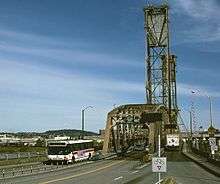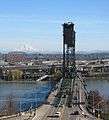Hawthorne Bridge
| Hawthorne Bridge | |
|---|---|
_from_southwest%2C_2012.jpg) | |
| Carries | Vehicles, pedestrians, cyclists |
| Crosses | Willamette River |
| Locale | Portland, Oregon |
| Maintained by | Multnomah County |
| Characteristics | |
| Design | Parker truss[1] with a vertical-lift span |
| Material | Steel |
| Total length | 1,382 feet (421 m) |
| Width | 73 feet (22 m) |
| Longest span | 244 feet (74 m) |
| Number of spans | 6 (excluding concrete girder approach spans) |
| Piers in water | 6 |
| Clearance below | 49 feet (15 m) closed, 159 feet (48 m) open |
| History | |
| Opened | December 19, 1910 |
| Statistics | |
| Daily traffic |
30,000[1] |
|
Hawthorne Bridge | |
|
Portland Historic Landmark[2] | |
| Location | Portland, Oregon; Willamette River at river mile 13.1 |
| Coordinates | 45°30′48″N 122°40′15″W / 45.513204°N 122.670937°WCoordinates: 45°30′48″N 122°40′15″W / 45.513204°N 122.670937°W |
| Built | 1910 |
| Architect | Waddell & Harrington |
| MPS | Willamette River Highway Bridges of Portland, Oregon |
| NRHP Reference # | 12000932 |
| Added to NRHP | November 14, 2012[3] |
The Hawthorne Bridge is a truss bridge with a vertical lift that spans the Willamette River in Portland, Oregon, joining Hawthorne Boulevard and Madison Street. It is the oldest vertical-lift bridge in operation in the United States[1] and the oldest highway bridge in Portland. It is also the busiest bicycle and transit bridge in Oregon, with over 8,000 cyclists[4] and 800 TriMet buses (carrying about 17,400 riders) daily.[1] It was added to the National Register of Historic Places in November 2012.[3][5]
Statistics
The bridge consists of five fixed spans and one 244-foot (74 m)-long vertical-lift span. It is 1,382 feet (421 m) in total length.[1] The bridge was originally 63 feet (19 m) wide,[6] including two five-foot sidewalks, but the sidewalks were widened to 10 feet in 1998, increasing the structure's overall width to 73 feet (22 m).[1] The 880,000-pound (400,000 kg) counterweights are suspended from the two 165-foot (50 m)-tall towers.[1] While the river is at low level, the bridge is 49 feet (15 m) above the water, causing it to be raised an average of 200 times per month. As of 2001, the average daily traffic was 30,500 vehicles. The bridge was designed by Waddell & Harrington, which also designed the Steel and Interstate bridges.[1] John Alexander Low Waddell invented the modern-day vertical-lift bridge.[1]
History
The current bridge was built to replace the second Madison Street Bridge, a wooden bridge built in 1900. It cost $511,000 to build[7] and was opened on December 19, 1910.[1] Hawthorne Boulevard (and thus the bridge) was named after Dr. J.C. Hawthorne, the cofounder of Oregon's first mental hospital and early proponent for the first Morrison Bridge.[1]
The streetcar tracks across the bridge were originally in the outer lanes,[8] but were relocated to the center lanes in 1931.[9] The deck was changed from wood to steel grating in 1945.[1]

In 1985 the lift span sheaves, the grooved wheels that guide the counterweight cables, were replaced. The bridge went through a $21 million renovation from 1998–99, which included replacing the steel grated deck and repainting.[1][10] The original lead-based paint was completely removed and replaced with 3 layers of new paint that is estimated to last 30 years.[11] During this upgrade the sidewalks were widened to 10 feet (3.0 m), making it a thoroughfare for bicycle commuters. Due to the replacement of the steel deck during this project, the channels which used to carry the rails for streetcars and interurban trains were also removed. The bridge was closed for one year to permit the renovation to be carried out.[1]
The original color of the bridge was black, lasting until 1964, when it was repainted yellow ochre.[12] During the 1998–99 renovation, the color was changed to green with red trim.[1]
In 2001, the sidewalks were connected to the Eastbank Esplanade. In 2005, the estimated cost to replace the bridge was $189.3 million.[13]
The 2003 film, The Hunted, included a scene set on MAX on the Hawthorne Bridge. Since MAX does not cross the bridge, the movie company connected two articulated buses remodeled to resemble a MAX train, complete with fake overhead lines and a sprinkler system to simulate rain.[14][15] Light-rail (interurban) service did cross the Hawthorne Bridge until 1956.[16]
The new deck put in place in the outer lanes during the 1998–99 renovation was designed to be strong enough for possible use by modern, heavier streetcars or light rail trains in the future,[17][18] which was proposed at that time,[17] and TriMet was still considering a Hawthorne Bridge routing for its future MAX Orange Line, to Milwaukie, in 2002.[19] However, following the transit agency's later decision to build the Tilikum Crossing for the Milwaukie MAX line, which bridge could also be used by the Portland Streetcar,[20] it became unlikely that rail cars will ever again cross the Hawthorne Bridge.
In August 2012, an automated bicycle counter was installed on the bridge, the first such counter to be installed in a U.S. city. It was purchased by the non-profit group Cycle Oregon and donated to the city.[21] The bridge was added to the National Register of Historic Places[22] in November 2012.[5]
Pop culture references
- Elliott Smith mentions the Hawthorne Bridge in the song "I Can't Answer You Anymore."[23]
Gallery
 Panoramic view from the southeast
Panoramic view from the southeast From the Eastbank Esplanade
From the Eastbank Esplanade Seen from the west
Seen from the west Cyclists waiting during a bridge lift
Cyclists waiting during a bridge lift Lift span being raised
Lift span being raised Sidewalk view from the west in 2012
Sidewalk view from the west in 2012 The bridge at night
The bridge at night The bridge at night – panoramic view
The bridge at night – panoramic view Panoramic view from south and west
Panoramic view from south and west
See also
- Hands Across Hawthorne
- List of bridges on the National Register of Historic Places in Oregon
- List of crossings of the Willamette River
References
- 1 2 3 4 5 6 7 8 9 10 11 12 13 14 15 Wood Wortman, Sharon; Wortman, Ed (2006). The Portland Bridge Book (3rd ed.). Urban Adventure Press. pp. 61–68. ISBN 0-9787365-1-6.
- ↑ Portland Historic Landmarks Commission (July 2014), Historic Landmarks -- Portland, Oregon (XLS), retrieved August 20, 2014.
- 1 2 "Weekly list of actions taken on properties: 11/13/12 through 11/16/12". National Park Service. November 23, 2012. Retrieved April 24, 2013.
- ↑ "2011 Bicycle Counts Report" (PDF). Portland Bureau of Transportation. p. 4. Retrieved April 24, 2013.
- 1 2 Tims, Dana (November 20, 2012). "Four Multnomah County bridges listed on National Register of Historic Places". The Oregonian. Retrieved December 9, 2014.
- ↑ Wood, Sharon (1989). The Portland Bridge Book (1st ed.). Oregon Historical Society Press. pp. 37–42. ISBN 0-87595-211-9.
- ↑ Smith, Dwight A.; Norman, James B.; Dykman, Pieter T. (1989). Historic Highway Bridges of Oregon. Oregon Historical Society Press. p. 115. ISBN 0-87595-205-4.
- ↑ Bottenberg, Ray (2007). Bridges of Portland. Arcadia Publishing. p. 12. ISBN 978-0-7385-4876-0. Retrieved August 21, 2016.
- ↑ "Bridge Open Tomorrow; Repairs of Hawthorne Span Now About Completed". The Oregonian, May 19, 1931, p. 6.
- ↑ "Hawthorne Bridge Rehabilitation". David Evans and Associates, Inc. Retrieved 2009-02-09.
- ↑ "Hawthorne Bridge Painting". Multnomah County. Retrieved 2006-11-09.
- ↑ "Portland Voices: Bridge aficionado has answers about Hawthorne colors" (interview with author Sharon Wood). (April 3, 1997). The Oregonian, p. MP-2.
- ↑ "Hawthorne Bridge Future Needs". Multnomah County. December 2, 2005. Archived from the original on March 16, 2006. Retrieved December 9, 2014.
- ↑ Don Hamilton (March 9, 2001). "Lights, camera, traffic jam: Filming and construction mean more delays". Portland Tribune. Archived from the original on June 8, 2011. Retrieved July 5, 2014.
- ↑ Jennifer Anderson (January 18, 2002). "Shhh! Explosions foil quiet attempt by 'The Hunted' to tiptoe back into town". Portland Tribune. Archived from the original on June 8, 2011. Retrieved July 5, 2014.
- ↑ "Work on [Morrison] Bridge Ramps to Bring Street Closure". The Oregonian, September 13, 1956, p. 1.
- 1 2 Stewart, Bill (July 31, 1997). "Streetcars will return to Portland/City will strengthen, repaint Hawthorne Bridge". The Oregonian, p. D1.
- ↑ "Welcome to the Rose City & NorthWestern: Only in Hollywood do trains still cross Portland's Hawthorne Bridge". TrainWeb. Archived from the original on 2007-12-16. Retrieved 2007-12-16.
- ↑ Don Hamilton (June 14, 2002). "Tri-Met, Metro study two light rail plans". Portland Tribune. Archived from the original on June 8, 2011. Retrieved July 5, 2014.
- ↑ "Portland-Milwaukie Light Rail Project Fact Sheet" (PDF). TriMet. December 2010. Retrieved 2010-12-17.
- ↑ Mayer, James (August 8, 2012). "North America's first bike counter starts work on the Hawthorne Bridge". The Oregonian. Retrieved August 18, 2012.
- ↑ Harden, Kevin (November 20, 2012). "Four downtown bridges earn historic honors". Portland Tribune. Retrieved November 20, 2012.
- ↑ "sweet adeline". Retrieved 2011-01-13.
External links
| Wikimedia Commons has media related to Hawthorne Bridge. |
- Hawthorne Bridge page on Multnomah County website
- Photo of the 1910 construction crew
- Hawthorne Bridge at Structurae
